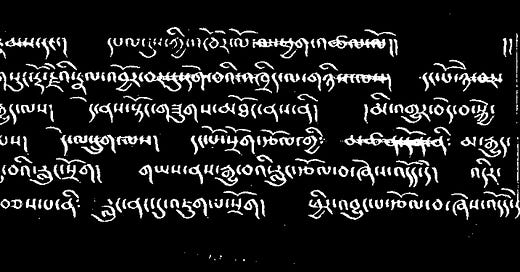Pranayama Instructions by Jonang Kunpang-pa
Translator’s Note
The following translation of pranayama instructions is simplified and incomplete. It is based on the Shadanga Yoga (Six Limbs of Yoga) text from the Kalachakra Tantra, composed by Kunpang-pa (13th-14th century) and associated with the Jonang tradition.
Meaning of the term pranayama
The term "pranayama" holds different meanings across various Vajrayana Tantra traditions. However, in this context, we adhere to the interpretation accepted in the Kalachakra Shadanga Yoga tradition.
1. Meaning of Pranayama According to Hevajra Mother Tantra and the Lamdre System: In these traditions, the air flowing through the left nostril is considered prana (སྲོག་), while the air flowing through the right nostril is referred to as ayama (རྩོལ་བ་).
2. Meaning of Pranayama According to Guhyasamaja Father Tantra and the Panca Krama System: In these traditions, the air that is inhaled is considered prana, while the air that is exhaled is referred to as ayama.
3. Meaning of Pranayama According to Kalachakra Nondual Tantra: In this tradition, prana refers to the air, while ayama signifies the cessation of the movement of air through the right (sun) and left (moon) channels. Pranayama stops the flow of karmic air through the sun and moon channels, which are associated with the conceptual mind. It then directs the ten vayus (five primary and five secondary) into the central channel, the channel of non-conceptual wisdom.
Vajra breathing practice
Vajra breathing should precede all other breathing practices and is also practiced between sessions to purify the body's three channels and balance the elements. The practice consists of three stages: inhalation, retention, and exhalation, each accompanied by a specific mantra sound—Om, Hum, and Ah, respectively. Practice inhalation, retention, and exhalation three times through each nostril—left, right, and both nostrils. When using both nostrils, the retention phase should be longer, while inhalation and exhalation should be shorter.
Signs of Yogic Experience in Vajra Breathing
Body: The practitioner experiences physical comfort and discomfort as a result of the release or obstruction of the three channels’ openings.
Breath: The practitioner becomes aware of the airflow and can discern which nostrils the air is passing through.
Mind: The practitioner recognizes the non-conceptual, luminous emptiness of the mind or awareness.
Gentle Breathing technique: Filling up the air and Emptying the air
How to Direct the Air into the Central Channel
Body (Leg Posture): If the air is flowing through the left nostril, bend your right leg and extend your left leg. If the air is flowing through the right nostril, reverse the leg posture [during the following breathing practice].
Breath: First, observe which nostril the air is flowing through. Then, expel any residual harmful air.
If the air is flowing through the left nostril: Gaze to the right side, gently squeeze the anus, and slowly draw the air inward towards the belly. With control, hold the breath while turning your gaze to the left. Release the air slowly through the right nostril, just before the sensation of discomfort arises.
When the air is flowing through the right nostril: Gaze to the left side and quickly expel the air through the right nostril. Then, slowly draw the air in towards the belly while contracting the anus. Turn your gaze to the left, hold the breath, and release the air slowly through the left nostril, just before the sensation of discomfort arises.
Note: This practice involves various complex breathing sequences and multiple sessions, which are omitted here for simplicity. It is said to be the supreme practice, capable of overcoming death and enhancing lifespan.
Signs of Yogic Experience
The practitioner experiences stillness in the breath, with no sensation of air movement. The air flows slowly and evenly through both nostrils. The mind remains in a non-conceptual, luminous state of emptiness, etc.
Kumbhaka of rough breathing method
Practising kumbhaka
Body (posture):
Sit in a round/circular posture with your legs crossed at the ankles, back straight, and arms crossed over the chest.
Breath:
Kumbhaka should be practiced when the air flows evenly through both nostrils. Keep your gaze centered, at the level of the eyebrows (neither left nor right). Expel the upper air, then immediately draw in the air and contract the anus. Unite the upper air and lower air, keeping them immobile. Then, meditate on non-conceptual samadhi (Nirvikalpa samadhi). When you can no longer hold the air, gently contract the anus [drawing the lower air upwards] and release the air through both nostrils. If you experience a burning sensation at the crown of the head or any pain in the head, discontinue the session.



